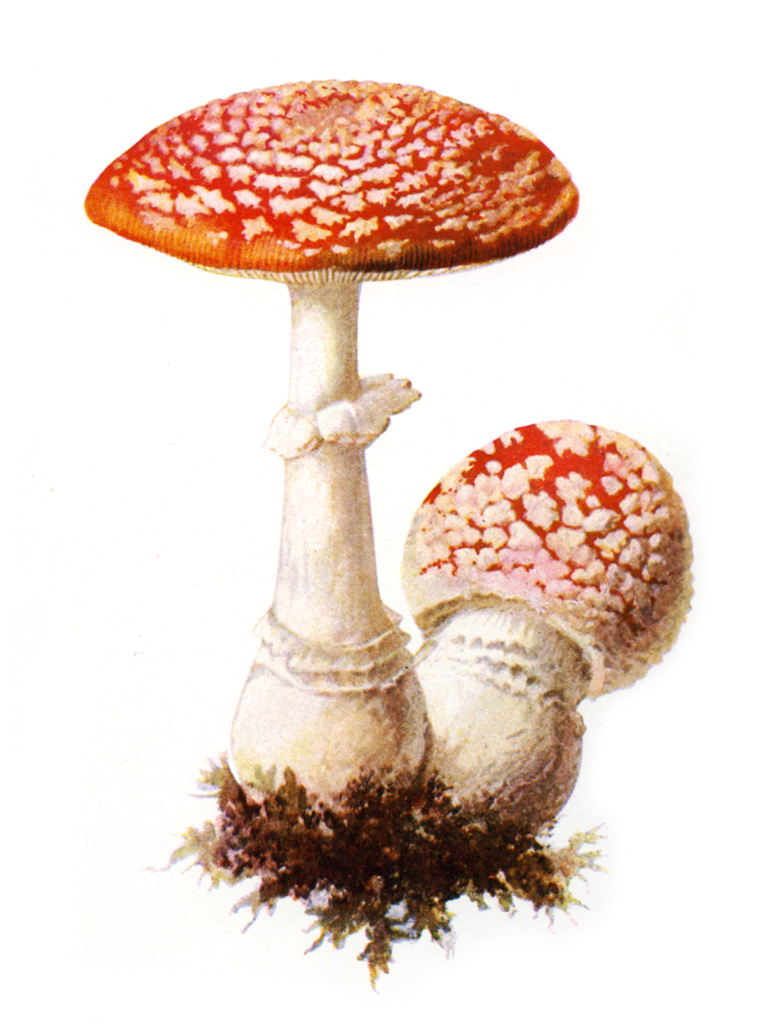- Amanita
image_width = 230px
image_caption = "Amanita muscaria "
Albin Schmalfuß, 1897
regnum = Fungi
divisio =Basidiomycota
classis =Agaricomycetes
subclassis =Hymenomycete s
ordo =Agaricales
familia =Amanitaceae
genus = "Amanita"
genus_authority = Pers.
type_species = "Amanita muscaria "
diversity = c.600 species
diversity_link = List of Amanita species
synonyms ="Aspidella"Thegenus "Amanita" contains about 600species ofagarics including some of the mosttoxic known mushrooms found worldwide. This genus is responsible for approximately 95% of the fatalities resulting frommushroom poisoning , with thedeath cap accounting for about 50% on its own. The most potent toxin present in these mushrooms isalpha-amanitin .The genus also contains many edible mushrooms, but mycologists generally discourage amateur mushroom hunters from selecting these for human consumption. Nonetheless, in some cultures, the larger local edible species of "Amanita" are mainstays of the markets in the local growing season. Samples of this are "Amanita zambiana" and other fleshy species in central
Africa , "A. basii" and similar species inMexico , "A. caesarea" inEurope , and "A. chepangiana" inSouth-East Asia . Other species are used for colouring sauces, such as the red "A. jacksonii" with a range from easternCanada to easternMexico .Many species are of unknown edibility, especially in countries such as
Australia where many fungi are little-known. Understandably, this is not a genus that lends itself to safe experimentation.Taxonomy
The name is possibly derived from Amanon, a mountain in
Cilicia .A first incarnation from "Tentamen dispositionis methodicae Fungorum" 65. 1797 is cited as devalidated: "Introduced to cover three groups already previously distinguished by
Christian Hendrik Persoon (in [...] Tent. 18. 1797) under "Agaricus" L., but at that time not named. It is worth stressing that the species now known as "Amanita caesarea" was not mentioned."With "
Agaricus " L. in use, "Amanita" was a "nomen nudum " per modern standard, so Persoon gave it a new life unrelated to its previous incarnations, and that is finally published after a starting date by Hooker (the citation is Pers. "per" Hook., 1821). He reuses Withering's 1801 definition ("A botanical arrangement of British plants", 4th ed.). "The name "Amanita" has been considered validly published on different occasions, depending on various considerations." Proposed types include (given as "Amanita". Sometimes they were selected as "Agarici")::*"A. livida" Pers. (By Earle, in 1909). Had been excluded in "Vaginata" or "Amanitopsis" and could not be chosen.:*"A. muscaria" Pers. (By Clemens & Shear, 1931) for the genus (1801) from "Synopsis fungorum", was generally transferred to the one from Hooker's "Flora of Scotland", which is currently considered the valid publication of "Amanita" (or was in the 50s).:*"A. phalloides" (by Singer, 1936) for the 1801 genus.:*"A.bulbosa" (by Singer & Smith, 1946) for Gray's republication. This is incorrect as Gray's "A. bulbosa" is a synonym of "A. citrina". Some authors consider Gray to be the first valid republisher.:*"A. caesarea" (by Gilbert, 1940). Troublesome because not known personally to Persoon or Fries.Donk concludes the earliest valid type is "A. muscaria", the species in Hooker, adding that he'd personally favor "A. citrina".The name has been republished three times in 1821: in Hooker, Roques and Gray (in that order). Roques maintained Persoon's circumscription, including "
Amanitopsis " and "Volvaria ". Gray excluded "Amanitopsis" and "Volvariella" into "Vaginata". Right after, Fries reset the name by reducing the genus to a tribe of "Agaricus", minus pink-spored "Volvariella ". This tribe became a subgenus, than genus via various authors, Quélet, although not the first, often being attributed the change. Sometimes it was used in a Persoonian sense (whether that is a correct use according to ICBN is not clear).Homonyms of "Amanita" Pers. are "Amanita" adans. (1763, devalidated) and "Amanita" (Dill) Rafin. (1830)
Toxicity
Several members of the section "Phalloidieae" are notable for their toxicity, containing toxins known as amatoxins which can cause liver failure and death. These include the death cap "A. phalloides", species known as destroying angels including "A. virosa", "A. bisporigera" and "A. ocreata" and the fool's mushroom "A. verna".
More recently, a series in the subgenus "Lepidella" have been found to cause acute renal failure, including "A. smithiana" of Northwestern North America, "A. pseudoporphyria" of Japan, and "A. proxima" of southern Europe. [cite journal |author=Saviuc P, Danel V |year=2006 |title=New Syndromes in Mushroom Poisoning |journal=Toxicological Reviews |volume=25 |issue=3 |pages=199–209 |id= |doi=10.2165/00139709-200625030-00004]
References
*cite journal| last=Donk| first=M.A.| title=The generic names proposed for Agaricaceae| journal=Beiheifte zur Nova Hedwigia| pages=1–320| volume=5| year=1962| issn= 0078-2238
External links
* [http://americanmushrooms.com/amanita.htm The Genus "Amanita"] - AmericanMushrooms.com.
* [http://pluto.njcc.com/~ret/amanita/mainaman.html Rodham E. Tuloss and Zhu-liang Yang's "Amanita" site] – Comprehensive listing of the nearly 600 named "Amanita" species with photos and/or technical details on over 510 species.
* [http://www.mushroomexpert.com/amanita.html "The genus "Amanita"] by Michael Kuo, "MushroomExpert.Com", March 2005.ee also
Destroying angel
Wikimedia Foundation. 2010.

